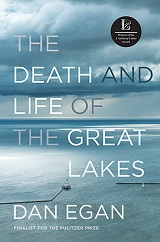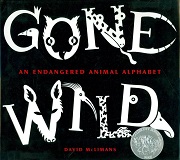Earth Days: The Environment & The Natural World
The Library hosts The Art and Activism of the Anthropocene in cooperation with Guernica magazine this April and May. The three-part series brings together writers, journalists, and artists to discuss how they address climate change, and why their work is particularly important in the Anthropocene Era. Inspired by this theme, the Library recommends a variety of books on the environment and the natural world. For related book recommendations, see our post on The Natural World of New York City.
The Death and Life of the Great Lakes | Dan Egan
The natural history of the Great Lakes is itself fascinating reading. But the story of the repeated environmental degradation of the Great Lakes and efforts to combat it make for a riveting story in the hands of Dan Egan. On the incredible size and unique configuration of the five lakes, he describes “one giant slow-motion river flowing west-to-east, with each lake dumping like a bucket into the next.” With simple maps and sections showing the varying depths from Lake Superior through Niagara Falls to the St. Lawrence River, he explains how the lakes were beneficially isolated from the oceans and other rivers until men created canals and locks for access of commercial shipping to the lakes. The unexpected consequences of this access, including predatory sea lampreys, invasions of zebra mussels, and toxic algae from agricultural run-off, is described in agonizing detail; but it is heartening to learn of the scientists and citizen activists who fought and still fight to overcome these incursions. The book is compellingly written and even suspenseful—it is still unclear if the good guys can win every battle—and I recommend it wholeheartedly to anyone interested in the future of our planet. —Jean Parker Phifer, Library Trustee
The Secret Life of Trees | Colin Tudge
In the introduction to The Secret Life of Trees, Colin Tudge reveals that his aim is to create connoisseurs of nature—connoisseurs requiring both knowledge and love. What follows could hardly do it better. The book, though quite scientific, is bursting with incredible facts about trees. Did you know that all flowering plants are believed to have one common ancestor? That nature’s desire to cooperate, called “convergent evolution,” resulted in the variety of plants we see today? That trees aren’t a subgroup of plants?—rather most of the 49 orders of plants contain at least one type of tree, even grasses (it’s bamboo). You’ll learn how mangrove forests survive in saltwater and why koalas have smaller brains. Perhaps most remarkably, you will learn that trees have memories and can analyze problems and find solutions. An astonishing subject revealed by an amazing book. —Patrick Rayner, Acquisitions Assistant/Circulation Assistant
 Animal, Vegetable, Miracle: a Year of Food Life | Barbara Kingsolver
Animal, Vegetable, Miracle: a Year of Food Life | Barbara Kingsolver
“You Can’t Run Away on Harvest Day” is the chapter I remember most from Animal, Vegetable, Miracle, by Barbara Kingsolver. While it is tempting to dwell on privileges that permit Kingsolver to live a life where she can raise her own animals and plants for food, one must also admire her commitment to doing the harvesting herself. The movement to eat more locally grown food has come a long way since the book’s publication ten years ago, but re-reading the aforementioned chapter still provides renewed inspiration for responsible choices about what we eat, whether vegetarian or omnivore. The great storytelling and engaging voice of one of my favorite authors also make reading about this transformative time of her life a pleasure. —Cathy McGowan, Circulation Librarian/Interlibrary Loan
The Gentle Art of Tramping | Stephen Graham
I have admittedly taken some liberties with the call for book recommendations related to environmental topics. But the ecological benefits of tramping (walking, hiking, backpacking, whatever you choose to call it) over other forms of transport in the Anthropocene are undeniable. So if you have not slowed down enough to enjoy a good stroll lately, I encourage you to pick up this 1926 treasure. Author Stephen Graham begins “know how to tramp and you know how to live,” and you are thus carried forth on a romp offering advice on the proper equipment (some of it dated, though no less enjoyable to read), as well as philosophical ramblings about how to enjoy the tramp itself (“the art of idleness,” “the dip,” “the artist’s notebook,” and the “zigzag walk,” which is just as it sounds). For a more contemporary philosophical and scientific view of the nature and history of trailmaking, I also recommend Robert Moor’s excellent On Trails: An Exploration. —Carolyn Waters, Head Librarian
The Peregrine | J.A. Baker 
The Peregrine is a singular work, uneasy in the company of books solely about the natural world. In diary form, J.A. Baker obsessively tracks and chronicles the hunting rituals of falcons in coastal East Anglia with single-minded immersion that seems to dissipate his sense of human self. Death-haunted, violent, and with a tone of muted melancholy, The Peregrine chronicles the desire for personal transformation and resurrection—”the hunter becoming the thing he hunts”—and the annihilation necessary to those ends. “To be out there at the edge of things, to let the human taint wash away as the fox sloughs his smell into the cold unworldliness of water; to return to town a stranger.” Although it was written when falcons were gravely threatened by pesticides and suburban sprawl, and mankind’s destructive force is a specter throughout, this is not a book of shrill protest. Baker’s command of observation and description reads more like a collection of poems. —Steven McGuirl, Head of Acquisitions
Memory of Water | Emmi Itäranta
In the time succeeding the Twilight Century —a period of darkness, war, and violent climate change not unlike now—Noria guards the secret knowledge that could save her community. Noria takes on the tradition of Tea Master from her father, with all the living memory and knowledge of water, despite the threat of the New Qian Military. In constant dialogue between Noria’s present and our historic present, Memory of Water discusses important themes of reusable and renewable resources, water restrictions, and knowledge as power. Memory of Water illustrates the responsibility each individual has for taking care of our environment, our natural resources, and each other now so that all generations can prosper. —Ashley-Luisa Santangelo, Bibliographic Assistant
CHILDREN'S LIBRARY
Every day is Earth Day in the Children’s Library! Here are a few titles from our Go Green list—find it in the Children’s Library, or go paperless and see it here.
The EARTH Book | Todd Parr
Colorful, amusing text and illustrations show how children can help protect the Earth.
Gone Wild | David McLimans
This alphabet book details the habitats of rare creatures and the threats that they face.
The Tree that Time Built | Mary Ann Hoberman & Linda Winston (eds.)
This poetry anthology celebrates the wonders of the natural world.
Me and Marvin Gardens | Amy Sarig King
A boy discovers a strange creature in his backyard and must decide how to protect it.
The Tree Lady | Joseph Hopkins
The “tree lady” decided that San Diego needed more trees and transformed it into the green oasis it is today.
Flush | Carl Hiaasen
Two kids gather evidence that someone is polluting the protected waters around their Florida Keys home.
Ship Breaker | Paolo Bacigalupi
In a future dystopian realm, a teen boy scavenges for a living, but when he stumbles across an abandoned girl, his plans are disrupted.

